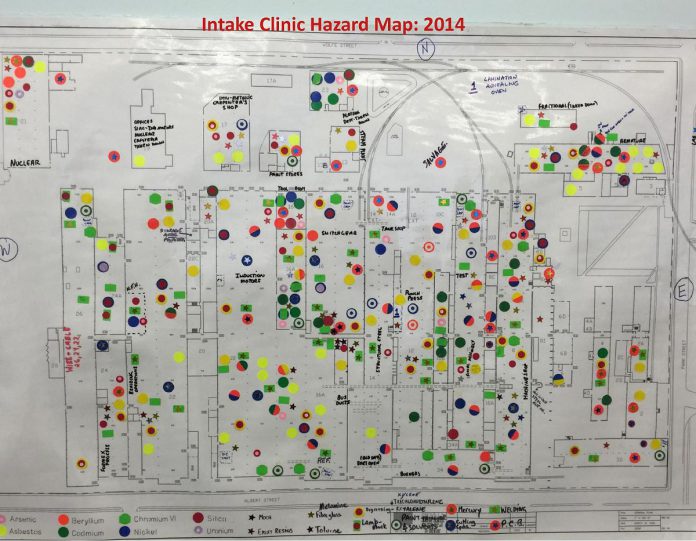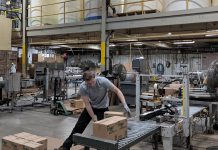
Despite environmental concerns, Peterborough city council will allow GEPR Energy Canada Inc. to demolish a large number of vacant buildings at the historic General Electric factory complex at 107 Park Street North in downtown Peterborough, with the exception of several buildings that a consultant hired by the company has identified as having heritage value.
Meeting as general committee on Monday evening (October 6), council considered a report from the city’s commissioner of infrastructure, planning, and growth management Blair Nelson that recommended hiring a consultant to conduct a peer review of a 154-page heritage impact assessment (HIA) report prepared by ERA Architects Inc. on behalf of GEPR Energy Canada Inc. — a report that was completed since the property is listed on the city’s heritage register, although it has not been designated.
GEPR Energy Canada Inc. is a subsidiary of GE Vernova, an energy equipment manufacturing and services company that was formed from the merger and subsequent spin-off of General Electric’s energy businesses in 2024.
After a discussion that lasted almost two hours, council ultimately decided against the staff recommendation to hire a consultant to conduct a peer review of the HIA report. Instead, council decided to accept the recommendations made in the HIA report for which buildings should receive heritage designation.
The General Electric factory complex began operations in 1891 as the Canadian Works of the Thomas Edison Company and later continued under General Electric. The site includes a complex of 33 buildings built between 1891 and 1981 and used for industrial manufacturing and ancillary purposes.
In 2018, General Electric ceased its manufacturing activities on the site, with most of the buildings now decommissioned with machinery and equipment removed. GE Vernova has maintained office space for 60 employees in the site’s east block and leases several buildings in the west block to BWXT, which was originally part of GE Vernova’s nuclear energy division but became an independent company in 2016 and now specializes in nuclear components and services for government and commercial clients.
GE Vernova is proposing demolishing and removing the buildings in the complex’s centre block that haven’t been used since 2018, which represent around 84,500 square metres (910,000 square feet) of the 104,000 square metre (1.1 million square feet) site. The buildings proposed for removal are identified as 6, 6B, 6D, 8, 8D, 8E, 8I, 10, 10A, 10B, 10C, 10D, 12, 12ext, 13, 13A, 14, 14A, 16, 16A, 18, 20, 20A, 22, 22C, and 34.
The buildings that would be retained because they are currently in use or have heritage value include those occupied by BWXT (buildings 21, 24A, 26, and 28) and GE Vernova (buildings 2 and 2A), as well as two unoccupied buildings (8A and 30) that will be retained and mothballed pending potential future uses.
Much of the discussion at general committee revolved around the contamination of the industrial site with hazardous substances over the past 125 years and the impact of a demolition on the safety of the surrounding residential neighbourhoods.
“Did anybody ask the representative from General Electric what they’re going to do about remediation of the property?” councillor Keith Riel asked commissioner Nelson. “Because historically, and if you look across Ontario, the brownfields that we have, the corporation removed the buildings, put a fence around it, and there it sits, and we’re going to inherit another huge brownfield in the city.”
A “brownfield” is a former industrial or commercial site where future use is affected by real or perceived environmental contamination. Many contaminated post-industrial brownfield sites sit unused because the costs to remove contamination may be more than the land is worth after redevelopment.
Nelson said GE Vernova’s interest in demolishing the buildings is for “mitigating the property and maintaining the property from the perspective of risk management and cost management,” with the city’s director of planning, development and urban design Brad Appleby adding that site plan amendment plans indicate the buildings will be demolished to a “cement pad state” followed by landscaping and stormwater management to avoid off-site impacts.
“They don’t have a redevelopment plan in place right now for the land that is, for the lack of a better term, being freed up,” Appleby said. “They are looking to contain what they have … There’s nothing that they are doing right now that would trigger the city’s ability to ask them to clean up, in terms of requiring records of site condition or anything like that, because they are not proposing a change in land use at this point in time.”
Councillor Riel, who spent over 38 years working at General Electric, referred to a past clinic that found that the site had the most chemicals and resulted in the most diseases in Canada.
“This is a huge problem. It’s built on a swamp and every chemical known to mankind is sitting there, and unless it’s remediated by General Electric, we’re going to have this cesspool in this piece of property in the centre of the city.”
Councillor Matt Crowley put forward an amendment to require GE Vernova, as a condition of the city approving demolition, to confirm that a phase two environmental site assessment has been completed, that any required remediation plans are in place, and that the company guarantees it will comply with provincial environmental legislation.

Councillor Alex Bierk referred to a 2017 Unifor report, prepared by occupational disease researchers with members of the GE Retirees Advisory Committee, that details the toxic chemical exposures at the General Electric site between 1945 and 2000. The report found workers were exposed to over 3,000 toxic chemicals, including at least 40 known or suspected human carcinogens.
“We have families and residents that are living on the fence line of this potential demolition,” Bierk said. “If you were living on the fence line of General Electric, would you have concerns if you heard, that after 100 years, they were contemplating the demolition of these buildings? I think we have to look into it … This is very different from me wanting to demolish a residential building on my property.”
Nelson noted that the company would be responsible for complying with provincial legislation and requirements when it comes to hazardous substances, and that it is not within the city’s authority or purview to require a clean up.
Mayor Jeff Leal referred to the city’s experience with the demolition of buildings at the former Outboard Marine Corporation (OMC) property, which was contaminated with carcinogenic degreasing fluids, and confirmed with Nelson that the provincial government would oversee the identification of hazardous substances and abatement plans.
In reference to councillor Crowley’s amendment to the motion, councillor Kevin Duguay noted that provincial legislation does not allow the municipality to require a phase one or a phase two environmental site assessment unless a change in land use is being contemplated.
“Commissioner Nelson has reminded us that, if a demolition were to proceed, it is subject to provincial oversight and very, very strict regulation abatement programs,” Duguay said. “If there are materials that have contamination, the manner in which they have to be treated, how they’re removed and to what extent, and what landfill sites they go to, that’s all provincially regulated. That is not our responsibility. Our responsibility this evening is decide if we wish to proceed with the designation of our property, and it includes the demolition of buildings.”
Councillor Crowley’s motion lost 5-6, with councillors Crowley, Bierk, Riel, Joy Lachica, and Mayor Leal voting in favour and councillors Don Vassiliadis, Dave Haacke, Andrew Beamer, Lesley Parnell, Kevin Duguay, and Gary Baldwin voting against it.
Councillor Parnell requested that the three parts of the original motion be separated out, and that council support that it has received a notice of intention for demolition but not support hiring a consultant to conduct a peer review of the HIA report completed by ERA Architects Inc. for GE Vernova. Parnell also requested that council not support the third part of the motion, that refers to staff consulting with the Peterborough Architectural Conservation Advisory Committee (PACAC) after receiving the peer review report. She said she would introduce two new amendments if councillors voted against the two parts of the original motion.
Parnell argued that there was no need to spend $35,000 to conduct a peer review of “something that has been so professionally done” and that GE Vernova has identified the buildings it would accept for heritage designation. She proposed amendments that would indicate to GE Vernova that council has no interest in pursuing heritage designation except for the buildings identified in the HIA report, and that council direct staff to consult with PACAC on the specified buildings being considered for designation.
Councillor Lachica noted that a peer review of the HIA report would ensure the matter is being considered “in a fair and objective way.”
“Checks and balances are important for a site of such significance that we need to take our time and care — to not insist on that is not doing our due diligence,” Lachica said, adding that PACAC has the right to look at the entire site that it listed on the heritage register.
After further discussion, councillor Parnell called the question (a procedural tactic to end debate), which carried 7-4 with councillors Lachica, Bierk, Crowley, and Riel voting against.
Council then voted on the three parts of the original motion.
Council voted 9-2 in favour of acknowledging receipt of the notice of intention for demolition, with councillors Lachica and Riel voting against. Council voted 4-7 against directing staff to complete a sole source procurement for a peer review of the HIA report, with councillors Lachica, Bierk, Baldwin, and Riel voting in favour. Council voted 5-6 against directing staff to consult with PACAC after receiving a peer review report, with councillors Lachica, Bierk, Crowley, Baldwin, and Riel voting in favour.
Following additional debate on Parnell’s first amendment to the original motion, councillors voted 8-3 in favour of indicating to GE Vernova that council has no interest in pursuing heritage designation of 107 Park Street North with the exception of buildings 2, 2A, 8A, 21, 24A, 26, 28, and 30, with councillors Lachica, Baldwin, and Riel voting against the amendment.
After more debate on Parnell’s second amendment to the original motion, councillors voted 10-1 in favour of directing staff to consult with PACAC on the buildings recommended for heritage designation, with only councillor Riel voting against the amendment.
Items endorsed by general committee will be considered for final approval at the city council meeting on Tuesday (October 14) following Thanksgiving Monday.


























